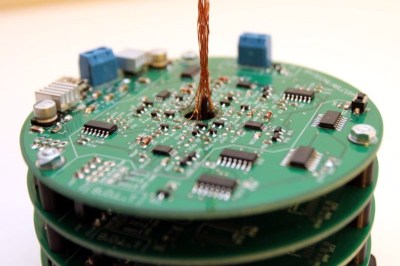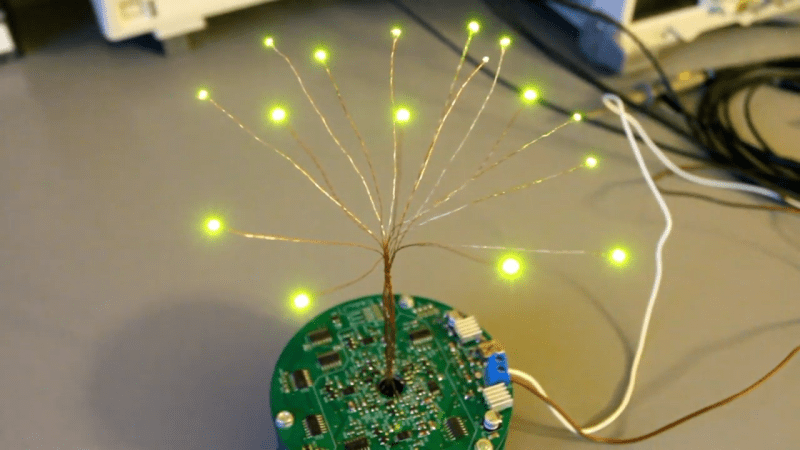The beautiful workmanship in [Andrew]’s LED tree is gorgeous all on its own, but of course there’s more going on than meets the eye. This LED tree can be blown out like a candle and it even playfully challenges a user to blow out all the lights at once in a single breath.
 Some of you may remember the fascinating example of an LED you can blow out like a candle which had the trick of using the LED itself as a sensor. Like any diode, the voltage drop across the LED changes very slightly based on temperature. By minimizing thermal mass with surface-mount LEDs and whisker-thin wires, it was possible to detect when the LED was being blown on.
Some of you may remember the fascinating example of an LED you can blow out like a candle which had the trick of using the LED itself as a sensor. Like any diode, the voltage drop across the LED changes very slightly based on temperature. By minimizing thermal mass with surface-mount LEDs and whisker-thin wires, it was possible to detect when the LED was being blown on.
The LED tree shown here uses the same basic principle, but with a few important changes. The electronics have been redesigned and improved, and the Arduino used in the original proof of concept is ditched for stacked custom PCBs. Each board has a diameter under 100 mm in order to take advantage of the fab house’s lower cost for small boards. [Andrew] says that while the boards required a lot of time-consuming hand soldering and assembly, the payoff was that five boards rang in at barely five dollars (plus shipping) and that’s hard to beat.
Watch the tree in action in the brief video embedded below.















nice i like how the stacked boards look like a pot. lol
The only thing that annoys me is the delay between blowing and them finally dimming
Which custom board shop did he use? I’d like to give them a try…
In the full article he says that he used PCBWay.
Fascinating LED sculpture. TLDR; Except for a JK Flip Flop, it’s a analog design (no uC). And of course it has an LM555. Component count is high, but that’s the price of admission when you want to make something in an unusual and interesting way.
could it be made more reactive? Analog is usually pretty fast, so I’m not sure.
It’s possibly a trade-off between sensitivity of the circuit to noise, versus the temperature-induced change in voltage drop that you’re looking for as the signal to turn off.
Also, it’s more of a challenge. I’m sure the only professions that would be capable of blowing those candles out easily would be politicians and lawyers, as few others are long-winded enough. :-)
I really wish we could all just forget about the 555.
Frustrating to amateurs and pros alike.
Well, pros wouldn’t touch them anyway.
Pros designed the flipping NE555!
This was a fun read. All of these LED temperature sensor articles are making me want to implement my own design…
On the picture (*) you can see some small heatsinks put on top of some components. The heatsinks are easy to get and i do have some, but i wonder what kind of glue(?) he used. Does anybody has a cheap stuff to recommend? The last time i looked heat-conductive-glue was expensive and only usable for several weeks or month once opened. Is this (still) true?
* https://bytechlab.com/content/uploads/2019/02/LED-tree-finished-top-view.jpg
Guessing they are the typical super cheap ‘raspberry pi heat sink kit’ or similar. They come with some double sided tape. At this kind of level you can just use sticky tape to hold them on. Since you’re not going to be cooling a PC processor with these tiny things, you can get away without proper heat-sink compound
In many cases ordinary epoxy should also work. just apply it as thin as possible.
Not was i was hoping for but thanks for the answers.